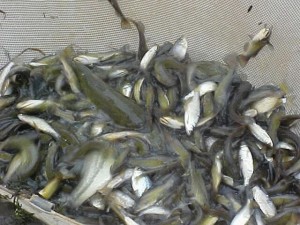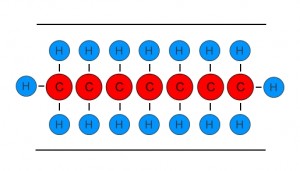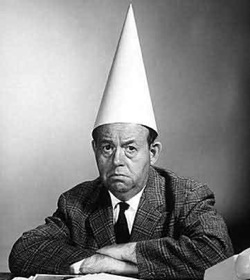Keeping what the market throws away (Key Tronic)
Warren Buffett once wrote that in financial analysis, having an IQ above 125 is wasted and that success in investing is largely a matter of temperament. This tells us two things, one, that the world’s greatest investor thinks that dispassionate adherence to investing principles is more important than fancy quantitative models, and two, that Warren Buffett’s IQ is 126.
 The most dispassionate method is the “net-nets†recommended by Ben Graham. These are firms whose working capital (cash and short term investments, receivables, and inventory) exceeds their total debts, and which are selling to a discount even to that. In other words, the current assets of the firm will pay for the purchase of the entire firm, and the firm’s longer-term assets and the future earning power they represent are available for free, or in fact, the current shareholders are paying you to buy them. The Snowball, Warren Buffett’s biography speaks of Benjamin Graham’s employees wearing lab coats and filling out forms to calculate whether a net-net existed. Nowadays, with SEC filings available online and the Excel spreadsheet having been invented, one would expect that these opportunities are harder to find, and indeed they are, and upon seeing them one might be curious as to why.
The most dispassionate method is the “net-nets†recommended by Ben Graham. These are firms whose working capital (cash and short term investments, receivables, and inventory) exceeds their total debts, and which are selling to a discount even to that. In other words, the current assets of the firm will pay for the purchase of the entire firm, and the firm’s longer-term assets and the future earning power they represent are available for free, or in fact, the current shareholders are paying you to buy them. The Snowball, Warren Buffett’s biography speaks of Benjamin Graham’s employees wearing lab coats and filling out forms to calculate whether a net-net existed. Nowadays, with SEC filings available online and the Excel spreadsheet having been invented, one would expect that these opportunities are harder to find, and indeed they are, and upon seeing them one might be curious as to why.
In theory, a diverse portfolio of these investments could be purchased without any further analysis, but as I’ve stated there may be something other than a depressed market at work. USEC Inc., for example, sold at less than its net working capital for a long period, but it was actually stockpiling cash in order to build its centrifuge plant, and we all know how that worked out.
Anyway, some kind person on the Internet has a screener to identify these opportunities. Most of them are over the counter or penny stocks, which are difficult to trade and subject to liquidity issues, which does suggest that neglect by the market is still a significant cause of these net-nets appearing. Some of them are in danger of delisting, which in theory does nothing to a firm’s operations, but usually does adversely affect its share price and also its access to capital markets. More troubling than trading difficulties, though, are operational difficulties; if the firm has a negative operating cash flow, it is quite conceivable that it will burn through the discount it sells for, thus robbing these issues of their apparent safety. Another issue is firms that reclassify their long-term investments to short-term, as with Asta Funding, a debt recycler on the list, has reclassified all of its portfolio of debts as receivables, when in reality they hold the debts for multiple years. Other firms may have inventories that need writing down.
But a firm that can avoid these troubles is almost by definition an attractive investment. Key Tronic Corporation (KTCC), manufactures circuit boards and other electronics. They have positive operating earnings, although they are a bit low in terms of return on capital, but more importantly they have 61 million in current assets, 27 million in debts, and 24 million in market cap, leaving a discount to current assets of $10 million, producing a 42% discount which makes a very decent margin of safety. Hence, this firm is worth more liquidated than it is valued at as a going concern, and when the economy improves and they have more orders, their return on assets should dramatically improve.
So, clearly fine returns can be made off what the market overlooks, if you do a little homework to make sure the market isn’t actually right.
 However, he does raise a good point; why should the shareholder pay management fees and submit to double taxation for a firm to hold financial assets that the shareholder could just go out and buy if the company had just issued a dividend instead of paying for the assets? The only possible explanation is that the firm is in fact capable of producing better investment results than the majority of its shareholders. Damodaran cites Berkshire Hathaway as a rare example of this firm; most corporate managers who are not Warren Buffett realize that investing in securities to produce above-average returns is difficult to do well and indefensible if done badly. Just ask any failed investment bank.
However, he does raise a good point; why should the shareholder pay management fees and submit to double taxation for a firm to hold financial assets that the shareholder could just go out and buy if the company had just issued a dividend instead of paying for the assets? The only possible explanation is that the firm is in fact capable of producing better investment results than the majority of its shareholders. Damodaran cites Berkshire Hathaway as a rare example of this firm; most corporate managers who are not Warren Buffett realize that investing in securities to produce above-average returns is difficult to do well and indefensible if done badly. Just ask any failed investment bank. Fairpoint recently acquired Verizon’s land lines in New England for $2.3 billion, which it turns out was a few hundred million too much, thus demonstrating the value investing principle that there are no good or bad investments, only good or bad prices. After all, anything can be at least liquidated, and with a bankruptcy in the works that is looking like a distinct possibility. Since that time, declining revenues have sunk their income, causing them to suspend their dividends in 2008 and now, it seems, to suspend their interest payments as well.
Fairpoint recently acquired Verizon’s land lines in New England for $2.3 billion, which it turns out was a few hundred million too much, thus demonstrating the value investing principle that there are no good or bad investments, only good or bad prices. After all, anything can be at least liquidated, and with a bankruptcy in the works that is looking like a distinct possibility. Since that time, declining revenues have sunk their income, causing them to suspend their dividends in 2008 and now, it seems, to suspend their interest payments as well. Obviously, it is too early to say anything, and the rumor of Windstream even buying the debt has not been confirmed, but since Windstream has embarked on two opportunistic acquisitions already in the last year, it would be a positive development for them to be feasting on Fairpoint’s corpse alongside the other vultures. As for ourselves, we like low-hanging fruit and have no objection if some fruit gets blown off the branch by a strong economic headwind. So, if the rumor is true this is another positive for Windstream, although they might want to recall that acquiring more than they can chew is what killed Fairpoint to begin with.
Obviously, it is too early to say anything, and the rumor of Windstream even buying the debt has not been confirmed, but since Windstream has embarked on two opportunistic acquisitions already in the last year, it would be a positive development for them to be feasting on Fairpoint’s corpse alongside the other vultures. As for ourselves, we like low-hanging fruit and have no objection if some fruit gets blown off the branch by a strong economic headwind. So, if the rumor is true this is another positive for Windstream, although they might want to recall that acquiring more than they can chew is what killed Fairpoint to begin with. Some of you may recognize our old friend the yield hog from the
Some of you may recognize our old friend the yield hog from the  As to borrowing the money from healthy banks, any effect on the private sector from removing the money would be dwarfed by the fallout from the massive bank run if an investor actually suffered a loss due to the bankruptcy of the FDIC. Of course, since the bankruptcy of the FDIC fund is not seriously an option this is not going to occur. However, it seems to be unreasonable for the FDIC to have to pay interest to one bank on behalf of the depositors of another. Using the Treasury’s line of credit would make more sense, although it does look like another bailout to the banking industry, and banks themselves are not looking forward to higher fees down the road to repay interest and principal.
As to borrowing the money from healthy banks, any effect on the private sector from removing the money would be dwarfed by the fallout from the massive bank run if an investor actually suffered a loss due to the bankruptcy of the FDIC. Of course, since the bankruptcy of the FDIC fund is not seriously an option this is not going to occur. However, it seems to be unreasonable for the FDIC to have to pay interest to one bank on behalf of the depositors of another. Using the Treasury’s line of credit would make more sense, although it does look like another bailout to the banking industry, and banks themselves are not looking forward to higher fees down the road to repay interest and principal. Calumet Specialty Products (CLMT) is an investment partnership that produces various petroleum products. It currently pays a dividend of 12.3%, and has a P/E ratio of 10.68, so it is almost covered. However, their earnings seem to have been fairly variable over the years and sales have been dropping from their heights, so this is probably not a good source of sustainable cash flow, although their dividends have been covered by operating cash flow, if not net earnings, for three of the last four quarters.
Calumet Specialty Products (CLMT) is an investment partnership that produces various petroleum products. It currently pays a dividend of 12.3%, and has a P/E ratio of 10.68, so it is almost covered. However, their earnings seem to have been fairly variable over the years and sales have been dropping from their heights, so this is probably not a good source of sustainable cash flow, although their dividends have been covered by operating cash flow, if not net earnings, for three of the last four quarters. Much of this fiddling with nonrecurrent events is the fault of accounting rules anyway. When it comes to goodwill, writeoffs take on an unusual character. Goodwill represents the purchase price paid to acquire a company that is in excess of the assets of that company. It represents the excess returns available from buying an established company instead of just replicating it, or, if you believe Damodaran, some of it comes from the “growth assets†of a company – the assets it will one day acquire to produce its growth and future excess returns. A lot of analysts advocate ignoring goodwill entirely, when it first shows up as an asset and when it is inevitably written down when conditions deteriorate. After all, if there are excess returns in a business they will show up in the income statement anyway, so counting both the excess returns and the goodwill looks like double counting. Goodwill nowadays, instead of being linearly written down over time, is now written down whenever, in the opinion of accountants, the excess returns it generated are no longer there. Since this essentially trades one accounting fiction for another, I can’t say that it’s solved the problem of dealing with intangibles, but it does make the data more frequently subject to large, discrete abnormalities.
Much of this fiddling with nonrecurrent events is the fault of accounting rules anyway. When it comes to goodwill, writeoffs take on an unusual character. Goodwill represents the purchase price paid to acquire a company that is in excess of the assets of that company. It represents the excess returns available from buying an established company instead of just replicating it, or, if you believe Damodaran, some of it comes from the “growth assets†of a company – the assets it will one day acquire to produce its growth and future excess returns. A lot of analysts advocate ignoring goodwill entirely, when it first shows up as an asset and when it is inevitably written down when conditions deteriorate. After all, if there are excess returns in a business they will show up in the income statement anyway, so counting both the excess returns and the goodwill looks like double counting. Goodwill nowadays, instead of being linearly written down over time, is now written down whenever, in the opinion of accountants, the excess returns it generated are no longer there. Since this essentially trades one accounting fiction for another, I can’t say that it’s solved the problem of dealing with intangibles, but it does make the data more frequently subject to large, discrete abnormalities. LINE is an oil and gas producer, and the bizarre PE ratio comes from the fact that, like many producers, they use derivatives to hedge their exposure to the price of oil and natural gas. However, accounting rules require them to record the changes in value of their derivatives during each earnings period, but they are not permitted to record the counterbalancing change in the oil and gas they hold. Since LINE holds three to five years’ worth of production of these derivatives, any hiccup in the price of oil or natural gas will affect those derivatives by several times what their current results will be affected by. So, ironically, the derivatives that are supposed to make their operations more stable make their reported earnings quite unstable.
LINE is an oil and gas producer, and the bizarre PE ratio comes from the fact that, like many producers, they use derivatives to hedge their exposure to the price of oil and natural gas. However, accounting rules require them to record the changes in value of their derivatives during each earnings period, but they are not permitted to record the counterbalancing change in the oil and gas they hold. Since LINE holds three to five years’ worth of production of these derivatives, any hiccup in the price of oil or natural gas will affect those derivatives by several times what their current results will be affected by. So, ironically, the derivatives that are supposed to make their operations more stable make their reported earnings quite unstable. It is, in fact, the New York Times Bestseller List. In a classic investment comedy book, Rothchild’s
It is, in fact, the New York Times Bestseller List. In a classic investment comedy book, Rothchild’s  As an aside, China has pegged its currency to the United States dollar for a number of years, in order to perpetuate the trade deficit and build up a substantial pile of Treasury holdings. We ran the price of oil up to $140 a barrel just to shake them off, and now they have the flaming nerve to
As an aside, China has pegged its currency to the United States dollar for a number of years, in order to perpetuate the trade deficit and build up a substantial pile of Treasury holdings. We ran the price of oil up to $140 a barrel just to shake them off, and now they have the flaming nerve to